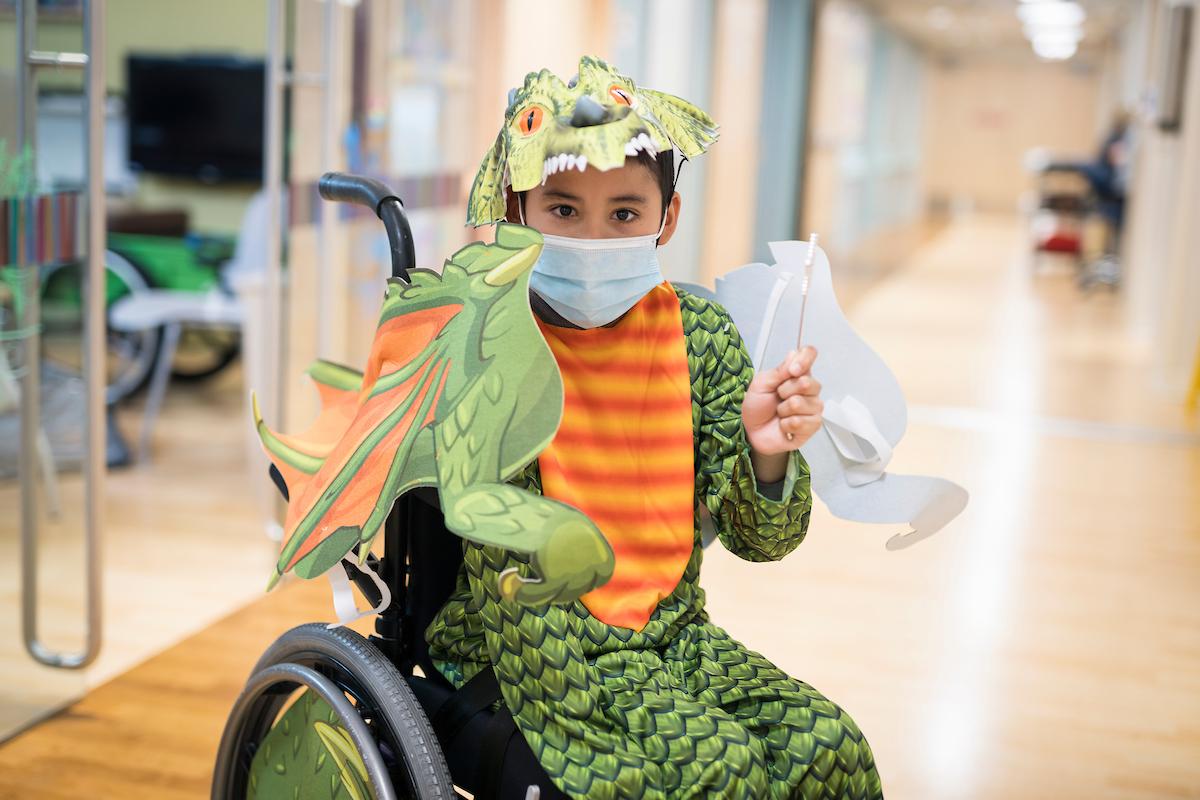Selective Dorsal Rhizotomy, a Great Dane and the Minnesota Twins: Cameron’s “Wild Journey” to Improved Mobility
Via CaringBridge, early May 2018: Cameron was born at 26 weeks along with his twin sister Kendall. Two days after Cameron was born he had bleeding on the brain. This bleeding caused him to develop cerebral palsy. Cerebral palsy causes impaired motor movements that can affect many areas of his body. – Stacy and Lenny, Cameron’s mom and dad Cameron is an outgoing ball of energy who loves making new friends. His bright red hair is a perfect match for his personality. Three days after Cameron and Kendall were born prematurely on May 10, 2012, Cameron’s parents were told that he would never walk, talk or eat on his own because of his brain bleed. They heard this devastating news on May 14, 2012—the day after Mother’s Day. Cameron defied these grim expectations—and he especially loves to talk!—but struggled with walking. So, this past summer, Cameron came to Gillette Children’s Specialty Healthcare for a major neurosurgery to address symptoms of his cerebral palsy. Via CaringBridge, early May 2018: On May 23, he will be having a surgery called selective dorsal rhizotomy (SDR) where they will cut the bad nerves in his back that go to his legs which cause tightness (spasticity). These bad nerves cause Cameron to walk with bent legs and causes his foot to drag. This surgery will come with a 6-week hospital stay with intensive in hospital therapy but the therapy will not end when he gets home. He will need daily outpatient physical therapy for several months. This is going to be a wild journey and we would like to keep all of our friends and family in the loop during this crazy adventure. – Stacy and Lenny Gillette is internationally recognized for its comprehensive approach to selective dorsal rhizotomy surgery, which includes an inpatient rehabilitation stay of four to six weeks. This inpatient time is crucial, as patients undergo daily physical therapy, occupational therapy and other activities designed to maximize their surgical outcome. During Cameron’s surgery, his neurosurgeon Peter Kim, MD, precisely cut the nerve rootlets that contributed to Cameron’s spasticity. Kim ultimately cut 37% of the nerve rootlets—the average is between 20 and 40%. For three days after surgery, Cameron needed to lay flat on his back with his legs straight. On the fourth day, he began using the Gillette Prone Cart. The colorful carts help post-rhizotomy kids stretch their hip muscles and strengthen their core and upper body muscles. They’re comfy and mobile, which means kids can begin discovering all that Gillette has to offer—a sunlight filled skyway featuring “I Spy” games, an outdoor healing garden, evening activities, and more. Cameron began his full days of therapies on the fifth day after his surgery. His schedule included school, occupational therapy, physical therapy, music therapy and therapeutic recreation. Via CaringBridge, May 31, 2018 – Day 8 After therapeutic rec today I found Cameron laying on his prone cart at the nurses station. He was chatting up all the staff and telling his jokes. They all adore him. He asks for daily hugs and they happily oblige. – Stacy As Cameron progressed in his recovery, he began splitting his time between his prone cart, a wheelchair, and a device called a stander. In physical therapy he started riding an adaptive bike and practiced crawling and sitting in different positions. He also started walking therapy using the Lokomat, a robotic device that supports children’s weight while training them to walk correctly. The device features interactive games and virtual reality activities to help entertain and motivate kids. Motivation also came in the form of a furry friend—a certified Animal-Assisted Therapy dog; Great Dane Bishop. Via CaringBridge, June 12, 2018 – Day 20 Cameron was so excited to see Bishop, the Great Dane today. I don’t think he realized how big Great Danes really are! He was huge! He was the motivation Cameron needed to have a good therapy session. He helped Cam with various therapeutic things like standing, knee walking, knee sitting, etc.– Stacy



Cameron’s homecoming on June 28 proved bittersweet for him and his parents—excitement paired with anxiety paired with sadness of saying goodbye to beloved nurses, therapists and friends. Like all kids who undergo selective dorsal rhizotomy, Cameron continued his rehabilitation even once home, through daily visits to Gillette’s Minnetonka Clinic, where he continued to practice walking with his walker, sitting, stair-climbing, and other strength- and skill-building exercises.
Via CaringBridge, June 29, 2018 – Home
At every end is a new beginning. We are home and trying to adjust to our “new” Cameron and our new routine. He has lots of restrictions, this soon after his surgery. The other night Cam started crying saying how he was going to miss all of his nurses. I know they all touched his heart in some way. A huge thank you to all of his therapists that helped get him stronger and on his way to eventually walking again. I should also thank his neurosurgeon Dr. Kim because none of this would be possible without his expertise and very stable fingers. – Lenny

It would be remiss not to note an extra special milestone Cameron celebrated with the Minnesota Twins over the summer. On July 15, 2018, he served as the team’s honorary captain—all part of Gillette’s annual partnership with the Minnesota Twins. He got to “score” the first run of the game, walking from 3rd base to home plate, and was greeted with a high-five from Minnesota Twins pitcher Taylor Rogers! In typical Cameron fashion, he chose this opportunity to walk, outside a hospital setting, for the very first time since his rhizotomy surgery. Cameron, for his part, says highlights from his hospital stay included making new friends, brushing Bishop the Great Dane therapy dog, and daily root beer flavored popsicles.









